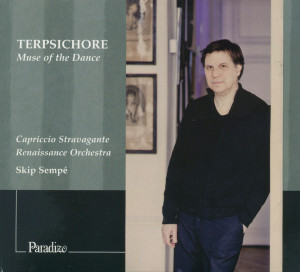Among period-instrument directors who established themselves as Baroque specialists, Skip Sempé is an anomaly. While nearly every one of his peers eventually abandoned the Baroque for (often disastrous) forays into Classical, Romantic, and even Modernist repertoire, in his now 25-year career Sempé has yet to follow suit. In fact, in an effort to advance his understanding of the Baroque, Sempé has often returned to Renaissance and even earlier repertoire.
Sempé’s acclaimed Monteverdi recordings for Deutsche Harmonia Mundi, as well as his later programs for Astrée Naive, are remarkably distinguished in their thoughtfulness, scope, and musicianship. Since founding his current label, Paradizo, a decade ago, Sempé not only has continued to explore pre-Baroque repertoire, but in 2011 he established the Capriccio Stravagante Renaissance Orchestra, whose spectacular debut recording, La Pelligrina—Intermedii 1589, proved to be another winner. The same can be said of this offering, Sempé’s second with the ensemble.
The program focuses mainly on works by the German composer Michael Praetorius, the best-known name associated with Terpsichore because of the large collection of dance tunes he named as such. His lesser-known contemporary William Brade (born in England though he established his reputation in Germany) also is well represented (only Hesperion XX’s now 30-year-old Deutsche Harmonia Mundi “Hamburger Ratsmusik” extravaganza has ever offered more Brade).
Praetorius’ arguably perfect overture and best-known work, the rousing Passameze from his Terpsichore Dances 1612, opens the disc. After it was introduced by David Munrow and the Early Music Consort, on their groundbreaking Praetorius recording for EMI in 1974, this gem has been included on nearly every subsequent Renaissance dance music compilation, and with good reason: it’s catchy, exciting, and simply a lot of fun. Sempé and colleagues perform it to the hilt. Unlike most performances, the percussion here is on equal footing with the brass and winds, effectively heightening the march momentum. The ensemble also is notably larger than usually heard here, creating a sense of grandeur that perfectly serves the spirit of the work.
In the booklet, Sempé defines Renaissance dance in the broadest sense, which is to say not merely a distinction between “country” and “courtly”; he also professes that some of it must have been intended simply as art music to be performed without dancers. While there are a number of larger-scaled works featuring the full orchestra, like the Passameze, the bulk of the program is devoted to smaller chamber settings. There are brass ensembles, brass and percussion ensembles, recorder quartets, viol consorts, settings for violin and keyboard as well as one for lute and keyboard, and more. Others feature more unorthodox instrumentation, such as Praetorius’ Bransles de Poictu Bransle double de Poictu, performed intermittently by string and recorder consorts. Brade’s Paduana, performed by a viol consort and percussion, is equally fascinating. There’s certainly no shortage of variety and diversity here, and no matter how large or small the setting everyone involved unfailingly rises to the occasion.
The sound is excellent, with a nice broad sound-stage and a remarkable sense of instrumental weight and clarity. As usual with Paradizo releases, Sempé offers a fascinating, erudite, and often entertaining interview. My only quibble is really just a suggestion: It would have been helpful if the instrumentation of each track had been provided, a detail that for many listeners would have added just that much more to the pleasure of the listening experience.
































